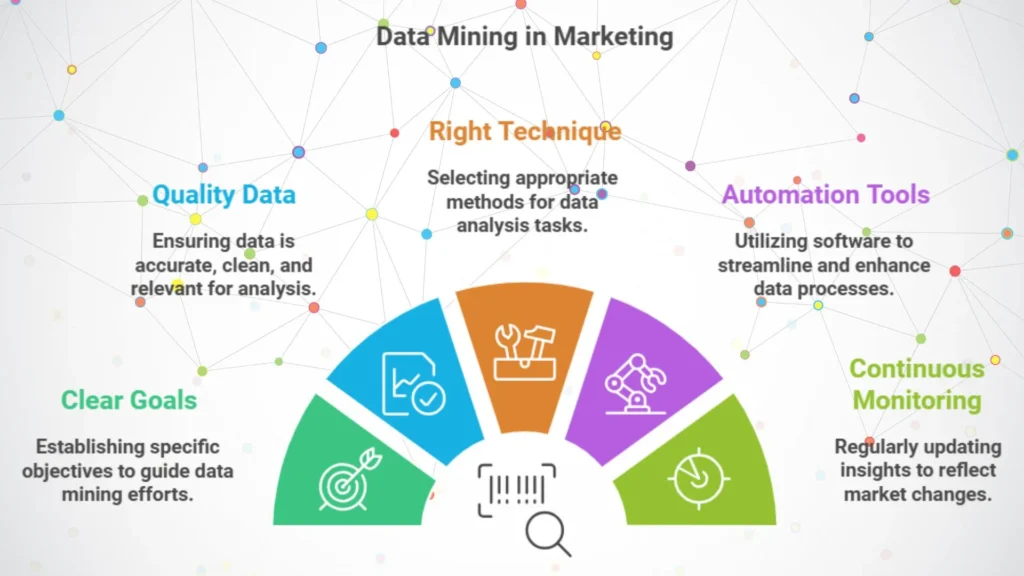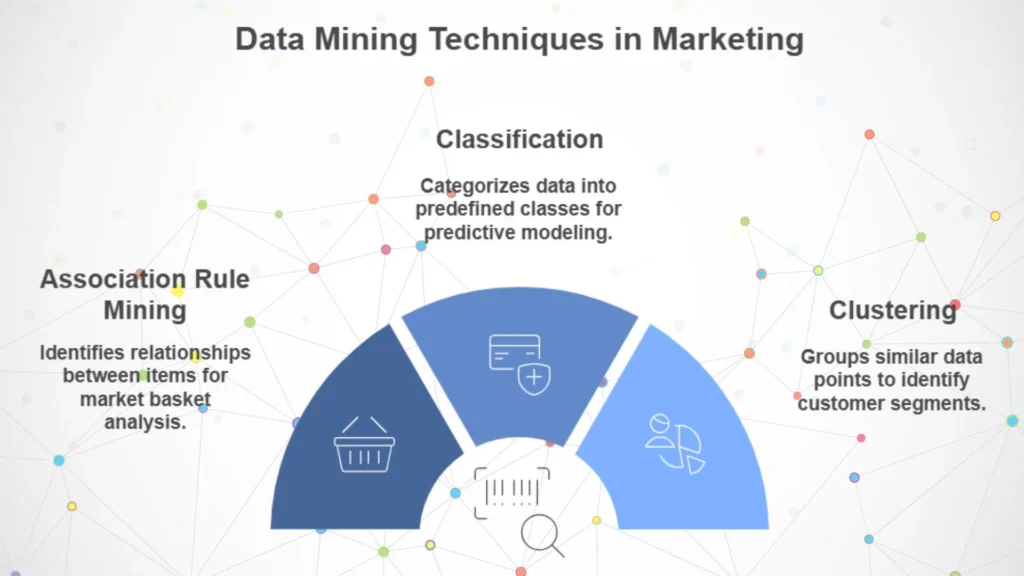Now a days, understanding customer needs and their behaviors is very important for a successful business. Since, so much data is generated every day, it is difficult for businesses to identify valuable information hidden within it. This is where data mining comes in picture. But what is data mining?
Data Mining is a powerful tool that helps vendors to extract patterns, trends and tips from large datasets using data analytics. The role of data mining in marketing is very important and it enables brands to understand their customers, apply their marketing efforts and create personalized experiences that cause engagement and loyalty.
In this guide, we shall explore the importance of data mining in marketing, key techniques like customer segmentation and the benefits of personalized marketing. We shall also provide actionable tips to help businesses to use data mining to create targeted marketing campaigns.
What is the Role of Data Mining in Marketing?
Data mining is the process of analyzing large datasets to find patterns, correlations and trends that are helpful to take business decisions. In marketing, data mining helps businesses to understand customer behavior, predict future trends and optimize their campaigns.

By using data mining, marketing personnel can take advantages of following:
– Identify Customer Segments: Group customers based on shared characteristics, like demographics, preferences and purchasing behavior.
– Discover Buying Patterns: Recognize trends that reveal when, why and how customers make purchases.
– Optimize Campaigns: Use information to personalize messaging and improve the effectiveness of marketing campaigns.
For example, Amazon uses data mining to recommend products based on previous customer purchases. This helps them create a more personalized shopping experience, which leads to higher customer satisfaction and increased sales.
Key Data Mining Techniques in Marketing
Marketing personnel use several data mining techniques to analyze customer data and make strategic decisions. Here are the most popular techniques:
1. Association Rule Mining
Association rule mining identifies relationships between items within a dataset. In marketing, this technique is widely used for market basket analysis, where companies look for products frequently bought together.
Example: A grocery store might use association rule mining to discover that customers who buy bread often buy butter as well. They can use this information to place these items close together on shelves or offer bundled discounts, to boost sales.
2. Classification
Classification is used to categorize data into predefined classes based on specific characteristics. This technique is especially valuable for predictive modeling, as it allows vendors to classify new customer data based on historical patterns.
Example: A credit card company might use classification to predict the likelihood of customers defaulting on payments. By analyzing past data, they can classify new customers as high risk or low risk, this helps them to offer personalized credit limits and interest rates.
3. Clustering
Clustering groups similar data points together, which allows businesses to identify distinct customer segments. Clustering is a valuable tool for customer segmentation, as it enables vendors to target specific groups with customized messages.
Example: A fashion retailer could use clustering to group customers by purchasing behavior. One cluster might include high spending customers who buy the latest trends, while another cluster includes budget conscious shoppers. Each group can receive suitable promotions to boost engagement.

Data Mining for Customer Segmentation: Creating Personalized Experiences
Customer segmentation is one of the most powerful applications of data mining in marketing. By analyzing customer data, businesses can divide their audience into segments based on demographics, behaviors and preferences. This enables brands to deliver personalized experiences that resonate with each group, which increases customer satisfaction and loyalty.
Types of Customer Segmentation
1. Demographic Segmentation: Based on age, gender, income, education and other personal characteristics.
2. Behavioral Segmentation: Based on purchasing behavior, product usage and engagement with the brand.
3. Psychographic Segmentation: Based on lifestyle, values and interests.
For instance, Netflix uses behavioral segmentation to recommend shows based on a user’s viewing history. This level of personalization keeps customers engaged and coming back for more.

Benefits of Data Mining for Customer Segmentation
1. Improved Targeting: By segmenting customers, businesses can target each group with messages and offers that resonate with their taste, to increase conversion rates.
2. Enhanced Personalization: Personalizing content for different customer segments makes customers feel valued, which leads to stronger brand loyalty.
3. Better Resource Allocation: Focusing marketing resources on high potential customer segments helps to optimize ad spend and maximize ROI.
Benefits of Data Mining in Marketing
Data mining offers several advantages that enhance the effectiveness of marketing efforts:
1. Improved Customer Feelings
Data mining helps marketers understand what drives customer decisions. By analyzing patterns in purchasing behavior, businesses can predict future trends and adjust their strategies accordingly.
Example: Starbucks uses data mining to analyze customer purchase history and create personalized promotions based on customer preferences. This approach boosts sales and also enhances customer loyalty.
2. Increased Marketing ROI
Data mining allows vendors to focus on high potential customer segments, which leads to more efficient campaigns. By targeting customers likely to respond positively, businesses can reduce marketing costs and increase return on investment (ROI).
3. Enhanced Customer Experience
By personalizing marketing messages and offers, data mining helps brands to create a seamless, enjoyable customer experience. Customers appreciate receiving relevant information, which develop loyalty and satisfaction.
Example: Spotify uses data mining to recommend songs and playlists made to match users’ preferences. This keeps users engaged on the platform and enhances their overall experience.
Practical Tips for Using Data Mining in Marketing
To get started with data mining in marketing, follow these tips:
1. Define Clear Goals: Decide what you want to achieve with data mining. This could be improving customer retention, boosting sales, or refining customer segmentation.
2. Collect Quality Data: Data quality is very important for effective analysis. Ensure your data is clean, accurate and relevant to your goals.
3. Choose the Right Technique: Select a data mining technique based on your objectives. For example, use clustering for customer segmentation and association rule mining for product recommendations.
4. Use Automation Tools: Many data mining tools, like IBM SPSS and RapidMiner, can help to automate analysis, which makes the process more efficient and accessible.
5. Continuously Monitor Results: Data mining is not a one time effort. Regularly review and update your information to stay aligned with changing customer behaviors and market trends.

Case Study: Coca-Cola’s Success with Data Mining
Coca-Cola is a main example of a brand that has successfully utilized data mining for marketing. The company collects large amounts of data from customer interactions, including social media and vending machines. Using data mining, Coca-Cola analyzes this data to understand consumer preferences and behaviors.
In one instance, Coca-Cola used data mining to identify that people often purchased soda during meal times. By matching their marketing efforts to promote drinks alongside meal combos, Coca-Cola saw a significant boost in sales. This approach helped Coca-Cola to increase revenue and also allowed them to personalize their promotions for different customer segments.
Ethical Considerations
Ethical data practices are important in any industry. Companies must be transparent about data usage and ensure that they have customers’ consent for data collection. Responsible data mining develops trust and helps brands to build a positive reputation.
Key Takeaways
– Data mining is a powerful tool for vendors to analyze large datasets and extract valuable insights.
– Techniques like association rule mining, classification and clustering enable businesses to understand customer behavior, segment audiences and optimize campaigns.
– Customer segmentation through data mining allows for personalized marketing, which leads to increased engagement and loyalty.
– Practical applications of data mining include market basket analysis, customer segmentation and predictive analytics, which makes it a versatile tool across industries.
– Real world examples, such as Netflix and Coca-Cola, demonstrate how data mining enhances customer experiences and push business growth further.
Conclusion:
Data mining can transform raw data into actionable tips that can elevate marketing strategies. As technology evolves, more businesses will likely to adopt data mining to better understand their customers and stay competitive in a rapidly changing market.

